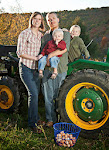 | |
| Cody is total poser... |
The first thing that we noticed is that this trailer pulled like a ton of bricks. That big huge fluid filled steel plate was at the very front of the trailer, which put all the weight on the hitch of my truck, instead of on the wheels and axles of the trailer. It also meant that it backed up squirrly.
So a friend of mine suggested some guys in the River Valley down by Ft. Smith that could rebalance the trailer. They got a big winch and winched the box off the trailer, and with a little welding here and there did a great job - here's the finished product.
Notice how far it is back on the trailer. That big heavy cold plate is right in front of the front wheel, right about where we'd want it to go. You can see here how it almost leans back towards the back of the trailer - a great improvement from the days when I had to use a floor jack to get it off the truck!
So now we've been working on getting the darn thing to run consistently. I take a lot of swings and misses here on the farm, and my capacity for patience is almost as great as those who deal with me on a regular basis. As you can see below, there's always plenty of opportunities to practice:
I've had a quick crash course in refrigeration, although I leave it in the hands of professionals. Turns out one of the things that I remember from my Chemistry is the Ideal Gas Law - PV=nRT. Who knew I would use it in the real world!?! There ought to be a reward for farmers who apply chemical laws throughout their day...
The latest hitch with the reefer unit turned out to be a bad start capacitor (I think), causing short cycling, where the unit would kick on and off after a couple of seconds - so basically making it useless. Now, I can plug it in (oh yeah, it runs off of 110v), and 24 hours later, it'll be around 30 degrees. Slap a generator on the front of the trailer and we're all set.
All told, it cost us around $5000 - which isn't bad when you consider it would run around $15,000 for a new trailer reefer unit. One of our friends leased one of these fancy new units and he said it was rickety and pretty flimsy. My experience is that when things were made in the 70s or 80s, flimsy usually never applies - unaerodynamic, ugly, or drug-induced possibly, but flimsy not so much.
The trailer is meant to haul around a 1000 birds, which we're getting around half that capacity per week. This is a good, necessary infrastructure buy for us. At some point, I'll get it swankied up with our logo painted on the side - but first I have to fix the tail lights...

.JPG)





